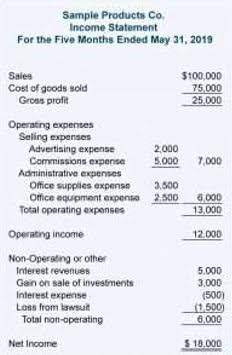
Cash Flow from operating activities (CFO) shows the amount of cash generated from the regular operations of an enterprise to maintain its operational capabilities. Cash flow from operations are calculated using either the direct or indirect method. Companies with strong financial flexibility fare better in a downturn by avoiding the costs of financial distress. Decreases in net cash flow from investing normally occur when long-term assets are purchased using cash. For example, in the Propensity Company example, there was a decrease in cash for the period relating to a simple purchase of new plant assets, in the amount of $40,000. Investing net cash flow includes cash received and cash paid relating to long-term assets.
- Cash Flow from operating activities (CFO) shows the amount of cash generated from the regular operations of an enterprise to maintain its operational capabilities.
- Net income and earnings per share (EPS) are two of the most frequently referenced financial metrics, so how are they different from operating cash flow?
- If Example Corporation issues additional shares of its common stock, the amount received will be reported as a positive amount.
- The net income on the Propensity Company income statement for December 31, 2018, is $4,340.
- The details about the cash flow of a company are available in its cash flow statement, which is part of a company’s quarterly and annual reports.
- To reconcile net income to cash flow from operating activities, add decreases in current assets.
Non-cash add-backs increase cash flow as they are not actual outflows of cash, but rather accounting conventions. The usual procedure is to offset on a monthly basis the individual income and expenses incurred in the respective month. A positive result is called a cash flow surplus; a negative result is called a cash flow deficit. IAS 7 was reissued in December 1992, retitled in September cash flow from operating activities 2007, and is operative for financial statements covering periods beginning on or after 1 January 1994. Regardless of the method, the cash flows from the operating section will give the same result. Although the profit or loss made on the sale of fixed assets is either credited (profit) or debited (loss) to the profit and loss account, these entries do not cause any cash movement.
What is the Statement of Cash Flows?
In addition, a company’s revenue recognition principle and matching of expenses to the timing of revenues can result in a material difference between OCF and net income. Accounts receivable increased by $4,786 million in the period and thus reduced the cash in the period by that amount since there was more revenue unpaid by customers. With that said, an increase in NWC is an outflow of cash (i.e. ”use”), whereas a decrease in NWC is an inflow of cash (i.e. “source”). Another current asset would be inventory, where an increase in inventory represents a cash reduction (i.e. a purchase of inventory). Typically, D&A is embedded within COGS/OpEx on the income statement, which reduces taxable income and thus net income. Additionally, it shows where we find the calculated or referenced data to fill in the forecast period section.
- The first section of the statement of cash flows is described as cash flows from operating activities or shortened to operating activities.
- The major drawback is that capital expenditures (CapEx) — typically the most significant cash outflow for companies — are not accounted for in CFO.
- The first option is the indirect method, where the company begins with net income on an accrual accounting basis and works backwards to achieve a cash basis figure for the period.
- Adam Hayes, Ph.D., CFA, is a financial writer with 15+ years Wall Street experience as a derivatives trader.
- To reconcile net income to cash flow from operating activities, subtract increases in current assets.
Financial documents are designed to provide insight into the financial health and status of an organization. You can find a collection of easy-to-use Excel cash flow templates at “Free Cash Flow Statement Templates.” You can customize and download them for free. The calculation shows the amount of cash your business has on hand at a specific point as a result of normal business operations. Inventory increased by $3,583 million in the period, which resulted in that amount of cash being deducted in the period (since an increase in inventory is a use of cash). Net income would be equivalent to CFO if net income were just comprised of cash revenue and cash expenses. Once the customer fulfills their end of the agreement (i.e. cash payment), A/R declines and the cash impact is positive.
3 Prepare the Statement of Cash Flows Using the Indirect Method
Investing activities include purchases of speculative assets, investments in securities, or sales of securities or assets. They may also receive income from interest, investments, royalties, and licensing agreements and sell products on credit. Assessing cash flows is essential for evaluating a company’s liquidity, flexibility, and overall financial performance.

Operating Cash Flow (OCF) is the amount of cash generated by the regular operating activities of a business within a specific time period. OCF begins with net income (from the bottom of the income statement), adds back any non-cash items, and adjusts for changes in net working capital, to arrive at the total cash generated or consumed in the period. Net income is the net after-tax profit of the business from the bottom of the income statement. To learn more about how the statements are deeply interconnected, read CFI’s guide to linking the three financial statements.
Operating Cash Flow vs. Net Income
A positive adjustment can also be interpreted to be favorable for the company’s cash balance. From the following information, calculate the net cash flow from operating activities (CFO). Operating activities is perhaps the key part of the cash flow statement because it shows whether (and to what extent) a business can generate cash from its operations. Operating activities are the transactions that enter into the calculation of net income. Examples include cash receipts from the sale of goods and services, cash receipts from interest and dividend income, and cash payments for inventory.
Cash inflows from operating activities are generated by sales of goods or services, the collection of accounts receivable, lawsuits settled or insurance claims paid. Businesses may also generate cash inflows by obtaining refunds or license fees. Given that it is only a book entry, depreciation does not cause any cash movement and, hence, it should be added back to net profit when calculating cash flow from operating activities.

Recent Comments